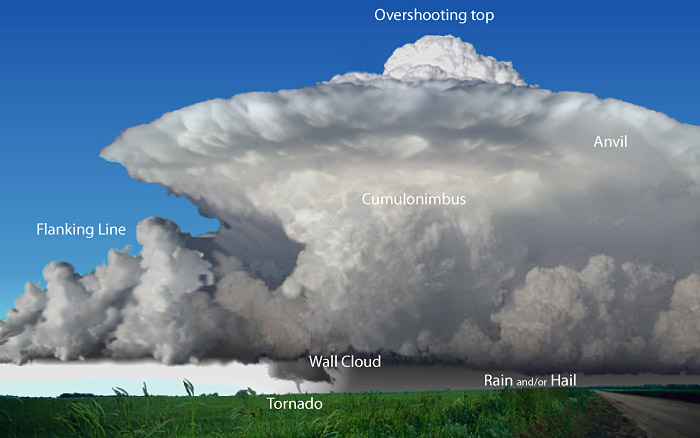 |
| A gargantuan hailstone that fell in Argentina Credit: Victoria Druetta |
 |
| How hail forms. Cr: Blog.weatherops.com |
 |
| Some of the features to be found in a supercell storm. Cr: NOAA |
WHAT IS A SUPER CELL THUNDERSTORM? -
A supercell is a thunderstorm characterized by the presence of a mesocyclone: a deep, persistently rotating updraft. For this reason, these storms are sometimes referred to as rotating thunderstorms
WHAT WAS THE PREVIOUS HAIL SIZE RECORD? -The previous hail record belonged to a 2010 hailstone from South Dakota that clocked in at 8 inches (20 centimeters) across. The Penn State team examined images of hail collected from the thunderstorm, interviewed eyewitnesses and surveyed damage in Villa Carlos Paz, a city in central Argentina and found a larger hail stone. Here's the story:
STORY OF THE RECORD-BREAKING HAILSTONE -
by Matthew Carroll, Penn State University May 6, 2020
A supercell thunderstorm pelted a city center in Argentina a few years ago with hailstones so large scientists suggested a new category to describe them—gargantuan hail.
Researchers investigating the 2018 storm found one hailstone likely measured between 7.4 and 9.3 inches across, potentially setting a new world record. The current record belongs to a hailstone that measured 8 inches across, or about the size of a volleyball, that fell near Vivian, South Dakota.
"It's incredible," said Matthew Kumjian, associate professor in the Department of Meteorology and Atmosphere Science at Penn State. "This is the extreme upper end of what you'd expect from hail."
The scientists proposed hail larger than 6 inches should be classified as gargantuan, and said more awareness of these events, while rare, could help piece together a better understanding of the dangerous storms.
"Anything larger than about a quarter in size can start putting dents into your car," Kumjian said. "In some rare cases, 6-inch hail has actually gone through roofs and multiple floors in houses. We'd like to help mitigate the impacts on life and property, to help anticipate these kinds of events."
 |
| Argentina hail was the size of a football! |
Researchers followed up on the accounts a year later, interviewing witnesses, visiting sites where damage occurred, collecting photogrammetric data and analyzing radar observations. Using photogrammetry—taking measurements from photographs—and video evidence, the scientists estimated one hailstone may have set a world record.
The scientists reported their findings in the Bulletin of the American Meteorological Society.
"Such a well-observed case is an important step forward in understanding environments and storms that produce gargantuan hail, and ultimately how to anticipate and detect such extreme events," Kumjian said.
Hail typically occurs during severe storms, which produce strong, sustained updrafts. The winds hold hailstones aloft long enough to grow in sub-zero temperatures high in the atmosphere. But predicting hail size remains challenging, the scientists said.
Rachel Gutierrez, a graduate student at Penn State and co-author of the paper, found a connection between a storm updraft's rotational velocity, or how fast it is spinning, and larger hail size, but much remains unknown about the relationship.
She said the data, especially from a storm outside the United States, is invaluable.
"There typically isn't a lot of data from storms outside the U.S.," Gutierrez said. "Having this shows us these crazy, high-impact events can happen all over the world."
Gargantuan hail events may be more common than once believed, but researchers need volunteers willing to report hail and provide accurate measurements, either by including a common item for scale, or a ruler, Gutierrez said.

No comments:
Post a Comment